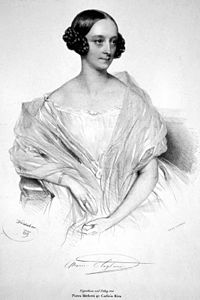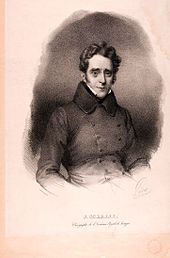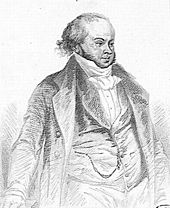425:
371:
42:
330:
927:
282:
241:. Their aim is to seduce the knight, Robert le Diable, into accepting a talisman to win him a princess. At the end of the ballet, the white-clad nuns return to their tombs. The ballet was created (in part) to demonstrate the building's newly installed gas lighting. The lighting was capable of creating ghastly effects.
446:
Critic and dance historian Andre
Levinson writes, "The academic dance had been an agreeable exercise to watch. Now, clarified matters of the soul. Ballet was a divertissement (an entertainment, a distraction). It became a mystery." Kisselgoff writes, "... the preoccupation with the supernatural that
297:
however was something entirely new in concept to audiences on the ballet's opening night. Henri
Duponchel, managing director of the Paris Opéra, was in charge of visual effects at the Opéra. He wanted to demonstrate the venue's recently installed gas lighting. Its reflectors produced a stronger, more
442:
wrote, "The diabolical music and the dead rising from their tombs and the terrible darkness and the strange dance unite to form a stage effect almost unrivaled. The famous witches' (nuns) dance in the freezing moonlight in the ruined abbey, was as impressive as expected ... They drop in like flakes
405:
about a dozen times. She left after six. It is possible that the erotic implications of the nuns' ballet did not set well with her. She may have been reluctant to appear in a ballet within an opera. A foot injury and the accidents that marred the first performance may have given the ballerina pause
365:
A crowd of mute shades glides though the arches. All these women cast off their nuns' costume, they shake off the cold powder of the grave; suddenly they throw themselves into the delights of their past life; they dance like bacchantes, they play like lords, they drink like sappers. What a pleasure
320:
included the scene in one of his novels. Andersen writes of the scene, "By the hundred they rise from the graveyard and drift into the cloister. They seem not to touch the earth. Like vaporous images, they glide past one another ... Suddenly their shrouds fall to the ground. They stand in all their
264:
Robert enters. The nuns hide, but return to prevent his escape. Robert stands terrified before a saint's tomb. The Abbess lures him towards the talisman in the saint's hand. Robert seizes it. The nuns continue their dance, fluttering like white moths. Their graves open and they sink into the earth.
337:
Opening night was spoiled by a falling gaslight and a trapdoor that would not close properly. A piece of scenery fell, narrowly missing
Taglioni. The curtain was brought down. The ballerina assured everyone she was unharmed. The curtain rose and the performance continued. It ended in a triumph for
277:
however ushered in a period that brought romantic ballet to the stage. Trapdoors, gas lighting, and other elements that became associated with the romantic ballet had been used in the popular theaters on the Paris boulevards for some time. Such elements would gain official sanction and prestige at
260:
The ballet opens with
Bertram, Robert le Diable's father, entering the ruined cloister of Sainte-Rosalie. He summons the ghosts of nuns who have violated their vows. They rise from their graves. He orders them to seduce his son Robert into accepting a deadly talisman. The Abbess Helena orders the
424:
309:
Europe rather than the classical world of Greece and Rome. After almost 100 years of rational thought, audiences were clamoring for the mysterious, the supernatural, the vague, and the doomed. The story of the ballet is about a knight who slips into a cloister at midnight to steal a
251:
as the Abbess Helena. Although opening night was marred with a few mishaps, Taglioni made her indelible mark on the ballet world in the role. She became known for her ethereal qualities and her moral purity, and is one of the most celebrated ballerinas in history.
370:
950:
302:, chief scenery designer. Ciceri was inspired by either the Saint-Trophime cloister in Arles or the cloister of Monfort-l'Amaury for the ballet's moonlit setting.
345:
a year. Her father was named ballet master with a three-year contract. Véron's boldness was rewarded when
Taglioni fulfilled her promise and became a great star.
341:
Dr. Véron had recently been awarded the Paris Opéra as a private enterprise. He had great faith in
Taglioni. He raised her salary to an unprecedented 30,000
769:
955:
719:
321:
voluptuous nakedness, and there begins a bacchanal." The nuns were not completely naked, but
Andersen did capture the essence of the scene.
659:
930:
817:
706:
684:
762:
960:
421:
between 1843 and 1863, on this. His choreography has been fully preserved. It represents the only record of the original.
261:
ghosts to waltz. In spite of their sacred vows, the nuns waltz. The dead nuns give themselves over to unholy thrills.
879:
755:
435:
443:
of snow and are certainly very charming witches with their jaunty
Parisian figures and most refined pirouettes."
305:
The theme of the ballet is passion and death, and love beyond the grave. The scene is night rather than day, and
299:
417:
saw
Fitzjames's performance as the Abbess in Paris in 1841. He based his own choreography, which was used in
406:
for thought. Bad press directed at her father may have caused
Taglioni to withdraw. Taglioni was replaced by
317:
394:. The opera was performed 756 times between 1831 and 1893 at the Paris Opéra. French Impressionist painter
895:
849:
841:
833:
113:
439:
414:
801:
793:
778:
702:
680:
655:
274:
197:
63:
857:
825:
407:
219:
206:
73:
715:
391:
193:
173:
41:
329:
911:
887:
695:
248:
211:
155:
101:
17:
944:
871:
447:
characterized so much of 19th-century ballet could be traced to the success of the
386:
223:
215:
188:
395:
273:
Ballet of the 18th century was based on rational thought and classical art. The
201:
418:
306:
265:
Stone slabs slide into place, covering the dead. A choir of demons is heard.
293:
theme was danced in Paris before Her Highness Mlle de Longueville in 1652.
281:
311:
238:
338:
Meyerbeer, the Taglionis, and Dr. Louis Véron, the Opéra's new manager.
903:
342:
747:
423:
369:
328:
280:
314:
from a dead saint's hand that will allow him to win a princess.
234:
751:
398:
painted the ballet scene several times between 1871 and 1876.
230:
298:
keenly directed light than ever before. Working with him was
27:
Episode in Giacomo Meyerbeer's grand opera, Robert le diable
278:
the Paris Opéra in the middle decades of the 19th century.
451:
in Meyerbeer's first production at the Paris Opéra".
353:
The audience took prurient delight in the scandalous
785:
169:
161:
151:
143:
133:
119:
109:
93:
79:
69:
59:
51:
34:
694:
697:Four Centuries of Ballet : Fifty Masterworks
210:. It was first performed in November 1831 at the
720:"Romantic Ballet began in an Opera by Meyerbeer"
401:Under her contract, Taglioni was to appear in
226:may have choreographed the entry of the nuns.
763:
8:
84:
951:Ballets premiered at the Paris Opera Ballet
926:
770:
756:
748:
676:Meyerbeer und das europäische Musiktheater
490:
31:
634:
622:
741:The Spectacle of the Past in Grand Opera
598:
585:
561:
549:
536:
524:
512:
471:
459:
580:
578:
576:
574:
572:
570:
508:
506:
504:
502:
500:
498:
486:
484:
482:
480:
467:
465:
463:
610:
7:
86:Quarante miracles dits de Notre-Dame
229:The short ballet tells of deceased
25:
956:Compositions by Giacomo Meyerbeer
679:, Laaber-Verlag, pp. 73–86,
654:, Dance Books, pp. 201–210,
410:, who danced the role 232 times.
925:
147:Sainte-Rosalie Cloister in ruins
40:
743:, in Charlton (2003), pp. 58–75
196:. It is an episode in Act 3 of
670:The "Ballet of the Nuns" from
1:
732:A Queer History of the Ballet
668:Jürgenson, Knud Arne (1998),
701:, Dover Publications, Inc.,
652:The Romantic Ballet in Paris
734:, Routledge, pp. 24–25
977:
880:Ein Feldlager in Schlesien
693:Kirstein, Lincoln (1984),
436:Henry Wadsworth Longfellow
285:Jean Coralli, date unknown
218:(now lost) was created by
922:
413:The Danish choreographer
366:to see these light women.
300:Pierre-Luc-Charles Ciceri
39:
739:Williams, Simon (2003),
730:Stoneley, Peter (2007),
818:Semiramide riconosciuta
318:Hans Christian Andersen
110:Original ballet company
805:(1813) (also known as
432:
378:
368:
334:
286:
85:
18:The Ballet of the Nuns
961:1831 ballet premieres
850:Il crociato in Egitto
674:and its Revival", in
427:
373:
363:
359:Revue des Deux-Mondes
357:. A reviewer for the
332:
284:
718:(December 2, 1984),
650:Guest, Ivor (2008),
428:Ciceri's design for
46:Marie Taglioni, 1839
539:, pp. 142–143.
415:August Bournonville
864:Ballet of the Nuns
842:L'esule di Granata
834:Margherita d'Anjou
802:Die beiden Kalifen
724:The New York Times
449:Ballet of the Nuns
433:
430:Ballet of the Nuns
379:
377:at the Paris Opéra
375:Ballet of the Nuns
335:
295:Ballet of the Nuns
287:
245:Ballet of the Nuns
233:rising from their
183:Ballet of the Nuns
165:Gothic Romanticism
114:Paris Opéra Ballet
35:Ballet of the Nuns
938:
937:
779:Giacomo Meyerbeer
637:, pp. 78–79.
275:French Revolution
198:Giacomo Meyerbeer
179:
178:
127:Helena, an Abbess
64:Giacomo Meyerbeer
16:(Redirected from
968:
929:
928:
896:L'étoile du nord
858:Robert le diable
826:Emma di Resburgo
772:
765:
758:
749:
744:
735:
726:
716:Kisselgoff, Anna
711:
700:
689:
672:Robert le diable
664:
661:978-185273-119-9
638:
632:
626:
620:
614:
608:
602:
595:
589:
582:
565:
559:
553:
552:, pp. 22–23
546:
540:
534:
528:
522:
516:
510:
493:
488:
475:
469:
408:Louise Fitzjames
291:Robert le Diable
220:Filippo Taglioni
207:Robert le diable
125:Robert le Diable
105:
104:
98:22 November 1831
88:
55:Filippo Taglioni
44:
32:
21:
976:
975:
971:
970:
969:
967:
966:
965:
941:
940:
939:
934:
918:
794:Jephtas Gelübde
781:
776:
738:
729:
714:
709:
692:
687:
667:
662:
649:
646:
641:
633:
629:
621:
617:
609:
605:
596:
592:
583:
568:
560:
556:
547:
543:
535:
531:
523:
519:
511:
496:
491:Kisselgoff 1984
489:
478:
470:
461:
457:
438:'s future wife
392:romantic ballet
351:
327:
271:
258:
194:romantic ballet
174:Romantic ballet
138:
137:Henri Duponchel
128:
126:
124:
100:
99:
97:
47:
28:
23:
22:
15:
12:
11:
5:
974:
972:
964:
963:
958:
953:
943:
942:
936:
935:
931:List of operas
923:
920:
919:
917:
916:
908:
900:
892:
884:
876:
868:
854:
846:
838:
830:
822:
814:
807:wirth und Gast
798:
789:
787:
783:
782:
777:
775:
774:
767:
760:
752:
746:
745:
736:
727:
712:
707:
690:
685:
665:
660:
645:
642:
640:
639:
635:Jürgenson 1998
627:
623:Jürgenson 1998
615:
613:, p. 205.
603:
590:
566:
554:
541:
529:
527:, p. 142.
517:
494:
476:
458:
456:
453:
440:Fanny Appleton
390:and the first
384:was the first
350:
347:
326:
323:
289:A ballet on a
270:
267:
257:
254:
249:Marie Taglioni
192:and the first
177:
176:
171:
167:
166:
163:
159:
158:
156:Marie Taglioni
153:
149:
148:
145:
141:
140:
135:
131:
130:
129:Ghosts of Nuns
121:
117:
116:
111:
107:
106:
95:
91:
90:
81:
77:
76:
71:
67:
66:
61:
57:
56:
53:
49:
48:
45:
37:
36:
26:
24:
14:
13:
10:
9:
6:
4:
3:
2:
973:
962:
959:
957:
954:
952:
949:
948:
946:
933:
932:
921:
914:
913:
909:
906:
905:
901:
898:
897:
893:
890:
889:
885:
882:
881:
877:
874:
873:
872:Les Huguenots
869:
866:
865:
860:
859:
855:
852:
851:
847:
844:
843:
839:
836:
835:
831:
828:
827:
823:
820:
819:
815:
812:
808:
804:
803:
799:
796:
795:
791:
790:
788:
784:
780:
773:
768:
766:
761:
759:
754:
753:
750:
742:
737:
733:
728:
725:
721:
717:
713:
710:
708:0-486-24631-0
704:
699:
698:
691:
688:
686:3-89007-410-3
682:
678:
675:
671:
666:
663:
657:
653:
648:
647:
643:
636:
631:
628:
625:, p. 76.
624:
619:
616:
612:
607:
604:
600:
599:Williams 2003
594:
591:
588:, p. 143
587:
586:Kirstein 1984
581:
579:
577:
575:
573:
571:
567:
564:, p. 23.
563:
562:Stoneley 2007
558:
555:
551:
550:Stoneley 2007
545:
542:
538:
537:Kirstein 1984
533:
530:
526:
525:Kirstein 1984
521:
518:
515:, p. 142
514:
513:Kirstein 1984
509:
507:
505:
503:
501:
499:
495:
492:
487:
485:
483:
481:
477:
473:
472:Stoneley 2007
468:
466:
464:
460:
454:
452:
450:
444:
441:
437:
431:
426:
422:
420:
416:
411:
409:
404:
399:
397:
393:
389:
388:
383:
376:
372:
367:
362:
360:
356:
348:
346:
344:
339:
331:
325:Opening night
324:
322:
319:
315:
313:
308:
303:
301:
296:
292:
283:
279:
276:
268:
266:
262:
255:
253:
250:
246:
242:
240:
236:
232:
227:
225:
221:
217:
213:
209:
208:
203:
199:
195:
191:
190:
186:is the first
185:
184:
175:
172:
168:
164:
160:
157:
154:
150:
146:
142:
139:Pierre Ciceri
136:
132:
122:
118:
115:
112:
108:
103:
96:
92:
89:
87:
82:
78:
75:
74:Eugène Scribe
72:
68:
65:
62:
58:
54:
52:Choreographer
50:
43:
38:
33:
30:
19:
924:
910:
902:
894:
886:
878:
870:
863:
862:
856:
848:
840:
832:
824:
816:
810:
806:
800:
792:
740:
731:
723:
696:
677:
673:
669:
651:
630:
618:
606:
601:, p. 71
593:
557:
544:
532:
520:
474:, p. 22
448:
445:
434:
429:
412:
402:
400:
387:ballet blanc
385:
381:
380:
374:
364:
358:
354:
352:
340:
336:
316:
304:
294:
290:
288:
272:
263:
259:
244:
243:
237:in a ruined
228:
224:Jean Coralli
216:choreography
205:
189:ballet blanc
187:
182:
181:
180:
83:
29:
912:L'Africaine
888:Le prophète
396:Edgar Degas
333:Louis Véron
212:Paris Opéra
202:grand opera
152:Created for
102:Paris Opéra
945:Categories
644:References
611:Guest 2008
584:Quoted in
548:Quoted in
419:Copenhagen
269:Background
120:Characters
597:Cited in
349:Reception
861:(1831) (
811:Alimelek
312:talisman
247:starred
239:cloister
94:Premiere
80:Based on
70:Libretto
904:Dinorah
144:Setting
123:Bertram
915:(1865)
907:(1859)
899:(1854)
891:(1849)
883:(1844)
875:(1836)
853:(1824)
845:(1822)
837:(1820)
829:(1819)
821:(1819)
797:(1812)
786:Operas
705:
683:
658:
361:wrote:
343:francs
307:Gothic
214:. The
134:Design
455:Notes
256:Story
235:tombs
162:Genre
60:Music
809:and
703:ISBN
681:ISBN
656:ISBN
403:Nuns
382:Nuns
355:Nuns
231:nuns
170:Type
200:'s
947::
722:,
569:^
497:^
479:^
462:^
222:.
204:,
867:)
813:)
771:e
764:t
757:v
20:)
Text is available under the Creative Commons Attribution-ShareAlike License. Additional terms may apply.



